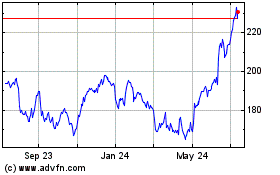Apple's Next iPhone Will Have a Curved Screen
February 28 2017 - 1:13AM
Dow Jones News
By Takashi Mochizuki
TOKYO-- Apple Inc. has decided to adopt a flexible display for
one model of the new iPhone coming out this year and has ordered
sufficient components to enable mass production, people familiar
with the matter said.
Apple had been studying flexible organic light-emitting diode or
OLED screens similar to those used by rival Samsung Electronics Co.
and had asked suppliers for prototypes, The Wall Street Journal
reported in November.
People with direct knowledge of Apple's production plans said
the Cupertino, Calif., company has decided to go ahead with the
technology, which allows manufacturers to bend screens in ways they
couldn't previously, and it will release a phone model using the
OLED screens this year.
An Apple spokeswoman declined to comment.
Using OLED displays would allow Apple to introduce a phone with
a new look to fuel sales. Apple's last major design overhaul came
with the iPhone 6, a slimmer phone with larger displays that helped
reignite sales growth and propel the company to record profits.
The iPhone 7, introduced in September 2016, came with a similar
design to its predecessor, contributing to slower sales in China.
Analysts say Chinese consumers feel more motivated to buy a new
phone when it has a different look that gives it appeal as a status
symbol.
Apple typically updates its iPhone lineup once a year, and this
year's update will come 10 years after the first iPhone hit the
market in 2007.
The anticipation of an anniversary iPhone with OLED technology
helped send Apple's share price to record highs in February. The
phone is expected to be priced at about $1,000, bringing the
average selling price of an iPhone in Apple's next fiscal year to
$684 from $666, according to BMO Capital Markets.
So far, all iPhones have used liquid-crystal displays, long the
standard for mobile devices and televisions. People familiar with
Apple's plans said its release this year would include two models
with the traditional LCDs and a third one with the OLED screen.
They said Apple would introduce other updates including a USB-C
port for the power cord and other peripheral devices instead of the
company's original Lightning connector. The models would also do
away with a physical home button, they said. Those updates would
give the iPhone features already available on other
smartphones.
In 2014, Samsung introduced its first phones with angled OLED
screens. Initially Samsung is set to supply the OLED screens to
Apple, despite their rivalry in the consumer market, because
Samsung is the only component maker capable today of making
sufficient quantities, the people familiar with the plans said. A
Samsung representative declined to comment.
Samsung is set to introduce its own updates in March to its
Galaxy smartphones, and those models will all have curved screens,
a person familiar with the matter has said. Samsung and Apple have
been running neck-and-neck recently for the No. 1 spot in global
smartphone shipments.
LG Display Co. and Japan Display Inc., major makers of LCD
screens, are working on OLED mass-production lines but aren't ready
to supply Apple yet, said people familiar with Apple's plans. An LG
Display representative declined to comment. A Japan Display
spokesman said the company expects to be ready for OLED mass
production by 2018.
Apple and Samsung are struggling to develop features that would
motivate consumers to replace their handsets frequently and
distinguish higher-end brands from affordable Chinese-made
handsets.
Hiroki Totoki, who is responsible for Sony Corp.'s smartphone
business, said in a recent interview that it is getting difficult
for companies to differentiate their new products, not just from
the competition but also from their own past models.
However, Mr. Totoki questioned whether OLED screens were the
answer, at least for now, saying current versions consume more
energy and cost more than the standard LCDs. Sony's latest
smartphones use LCDs to ensure the highest display quality, Mr.
Totoki said.
Tripp Mickle and Eun-Young Jeong contributed to this
article.
Write to Takashi Mochizuki at takashi.mochizuki@wsj.com
(END) Dow Jones Newswires
February 28, 2017 00:58 ET (05:58 GMT)
Copyright (c) 2017 Dow Jones & Company, Inc.
Apple (NASDAQ:AAPL)
Historical Stock Chart
From Mar 2024 to Apr 2024

Apple (NASDAQ:AAPL)
Historical Stock Chart
From Apr 2023 to Apr 2024
